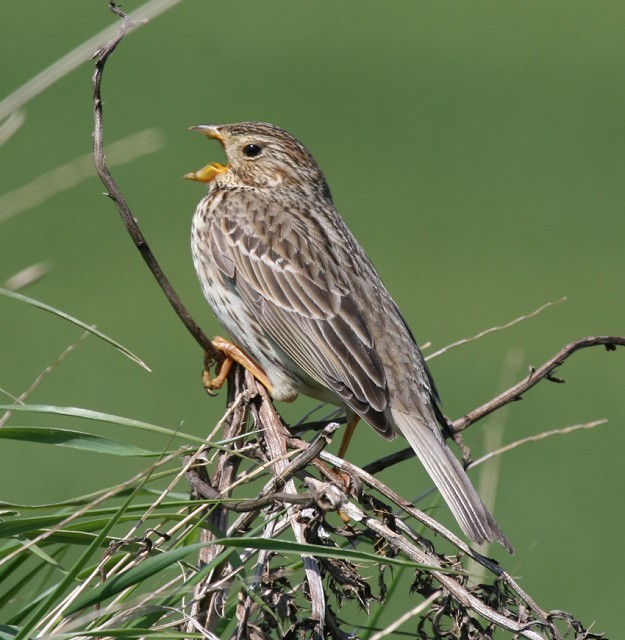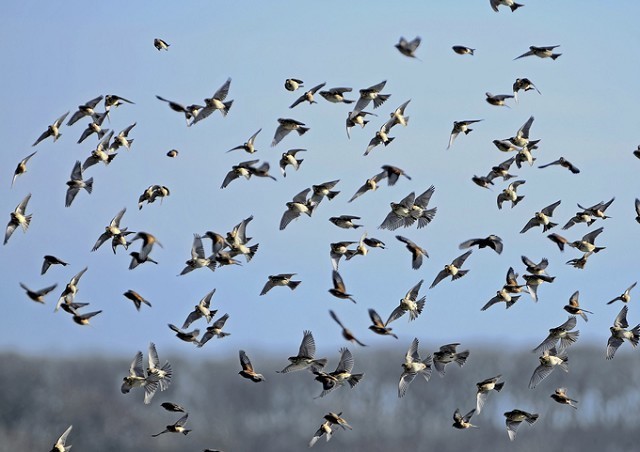Fat Bird of the Barley needs our help
The Corn Bunting was once a common sight across the Scottish lowlands, but is now rapidly disappearing. A recent study in Aberdeenshire and Angus showed an 83% decline in singing males across 30 sites between 1989 and 2007 (Watson et al., 2009), and only four of these areas remain occupied today.

Corn Bunting, St. Monans, Fife (Photo: Jacqui Herrington)
Research has shown that these declines are linked to changing agricultural practices that have reduced winter food supply and breeding productivity. Since 2002, RSPB Scotland have been working with over 70 farmers in Aberdeenshire, Inverness-shire, Fife and Angus in eastern Scotland, to:
- research factors affecting Corn Bunting populations
- trial practical management options to benefit Corn Buntings
- disseminate what we learn through advisory effort
Management options have been trialed through the RSPB's Farmland Bird Lifeline scheme, funded by Scottish Natural Heritage. The scheme specifically targets Corn Buntings and aims to deliver three key requirements: winter seed food, summer insect food and safe nesting areas.
Providing seed food throughout the winter and early spring is key to improving adult survival rates. This can be achieved by managing annually sown crops rich in cereal-grain which are left unharvested throughout the following winter, and retaining over-winter cereal stubbles.

Corn Bunting, Loch of Strathbeg RSPB, Aberdeenshire (Photo: Alan Sinclair)
Chicks are fed on insects collected from rough grassland, or low-input 'weedy' cereals. Management options include sowing and maintaining areas of species-rich grassland, grass margins around arable fields, and reducing pesticide use in 'conservation headlands' at the edges of cereal crops.
Corn Buntings nest later than other farmland birds (late May–August) and use dense vegetation such as cereal crops and grass silage. Nests are built on the ground and need to remain undisturbed into late July/August. Delayed mowing of grass and clover leys provides safe nesting habitat, whilst undersown or low-input cereals and large blocks of unharvested crops also offer safe nesting opportunities.
To maximise their use by Corn Buntings, these habitats need to be positioned within open landscapes and alongside features such as isolated groups of trees, short hedges or overhead telegraph wires. These offer suitable song posts next to potential breeding sites, whilst providing important refuge cover from predators.

Corn Bunting, Frampton Marsh RSPB, Lincolnshire (Photo: Matt Latham)
Monitoring during the first two years of the scheme showed that such management halted local population declines (Perkins et al., 2008). Following refinements to management options in more recent years, populations have now increased where the best package of options has been deployed. Between 2006 and 2009, there was a 48% increase in the number of singing males on 21 farms participating in Farmland Bird Lifeline.
RSPB monitoring of Corn Bunting breeding populations on farms participating in Scottish Government schemes such as the Rural Stewardship Scheme (RSS) has also shown that some of the management options deployed have helped Corn Buntings. On RSS farms, Corn Bunting populations generally remained stable, whilst on farms that were not in a scheme, populations declined.
The options included in the RSPB's Farmland Bird Lifeline scheme are now available in the Scottish Government's new scheme (Rural Development Contracts — Rural Priorities) as a Corn Bunting Package, aimed at farms within the species' remaining range in eastern Scotland. However, such habitats are currently only being managed within a fraction of the known Corn Bunting range. If the decline of the Corn Bunting is to be halted, there need to be more of these beneficial habitats provided across a wider area of the range. This action is urgently needed and could possibly be deployed through further targeting of existing Government agri-environment resource, or in the form of a specific large-scale Corn Bunting project.
Andrew Peddie farms land in Fife and has been managing habitats as part of the project since 2001: "It's been interesting and rewarding to see the Corn Bunting population increase on the farm. Monitoring has shown that some of the options managed are helping the buntings, whilst having no negative impact on my farming system. Perhaps if sympathetic management was spread over a wider area, species like the Corn Bunting may be able to co-exist with modern farming."
References
Perkins, A.J., Maggs, H.E., Wilson, J.D., Watson, A., Smout, C., 2008. Targeted management intervention reduces rate of population decline of Corn Buntings Emberiza calandra in eastern Scotland. Bird Study 55: 52-58.
Watson, A., Perkins, A.J., Maggs, H.E., Wilson, J.D., 2009. Decline of Corn Buntings Emberiza calandra on east Scottish study areas in 1989-2007. Bird Study 56: 213-220.

